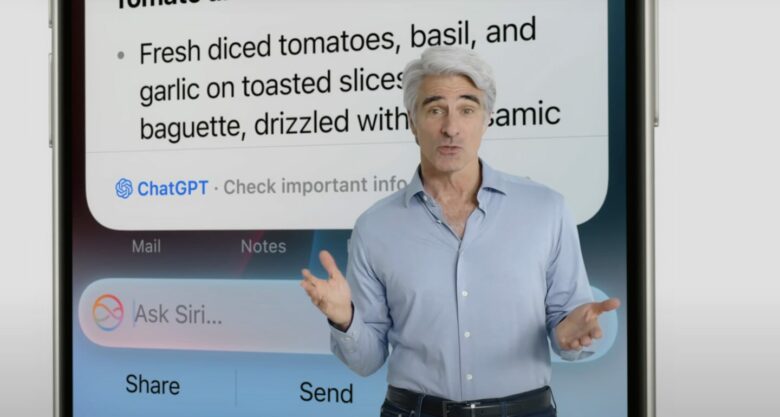WWDC 2024: Apple will integrate ChatGPT into iOS starting this fall

Earlier this week Apple confirmed at the WWDC developer conference what had long been rumored: Starting with the new operating systems iOS 18, iPadOS 18 and macOS Sequoia, which will be released in the fall, ChatGPT from OpenAI will be integrated directly into the Apple software – in addition to the in-house AI tools, which the iPhone company confidently calls “Apple Intelligence”.
The idea of Apple is to combine the power of generative models with personal context to enable helpful features on iPhone, iPad, and Mac. Deeply integrated into iOS 18, iPadOS 18, and macOS Sequoia, Apple Intelligence uses the full power of Apple’s own silicon to understand and generate language and images, perform actions in apps, and simplify everyday tasks.
ChatGPT will be integrated with the current AI model GPT-4.o, which is also used in many other AI tools such as Microsoft’s Copilot. The warning that ChatGPT can make mistakes will always be displayed. English-speaking US users will be able to use the features first, with additional languages being added over the course of 2025.
For OpenAI, the deal gives access to more than a billion potential new users. In the limited basic version, Apple users do not need a ChatGPT account; if you want the full feature, you can connect your paid ChatGPT account. It also requires relatively expensive devices, namely at least an iPhone 15 Pro, iPhone 15 Pro Max, and iPads and Macs with an M1 chip or newer.
Unlocking Success: How Brandly Digital tranforms business with creative Branding and AI
New features for language and communication
With the new system-wide “Writing Tools”, users can rewrite, proofread, and summarize the text in multiple programs. Whether revising lecture notes, perfecting a blog post, or an email, the Writing Tools provide support with functions such as “Rewrite,” “Proofread,” and “Summarize.”
Mail also makes it easier to keep track of things. Priority Messages prominently displays the most urgent emails and summaries allowing you to skim through messages. Smart Reply suggests quick replies and ensures that all questions are answered.
Image Playground for creative visual communication
“Image Playground” opens up exciting ways to create images and express yourself. Users can generate impressive images in seconds, choose between different styles, and integrate people from their photo library. Available directly in apps like Messages, they even get personalized concept suggestions to match their conversations.
Genmojis finally take emojis to a new level. By entering a description, you can create unique Genmojis, even of friends and family members based on photos. Like normal emojis, they can be inserted into messages or shared as reactions. This allows for a high degree of personalization.
AI feature makes Apple more valuable than ever, bigger than Nvidia
More control and creativity in photos
Photo search is now even more powerful with Apple Intelligence. You can find specific photos using natural language and jump directly to relevant scenes in videos. The new Clean Up Tool can be used to remove distracting objects in the background without accidentally changing the subject.
Flashbacks automatically create a story with the best photos and videos based on a description. Apple Intelligence identifies topics, organizes them into chapters, and adds a narrative arc – and you’ve got an impressive film.
Siri becomes more personal and powerful
Thanks to Apple Intelligence, Siri is more deeply integrated into the system functions. With comprehensive language understanding, Siri acts more naturally, relevantly and personally. You can make requests by text or voice and switch seamlessly between the two.
Siri can now help with thousands of questions about how something works on iPhone, iPad, and Mac. Siri also recognizes what’s on the screen and performs related actions, like adding an address from Messages to the contact card.
Dangerous: OpenAI develops voice cloning tool in super election year
ChatGPT to fatten up Siri
The fact that ChatGPT from OpenAI is integrated despite the many in-house AI features also shows that Apple is still behind in the development of AI language models (LLMs), and that it is sending another company to blame when the AI hallucinates and spouts false information, lies or nonsense.
ChatGPT is not generally turned on but is only intended to be used sporadically where Apple Intelligence does not know what to do next. “Users are asked for permission before sending questions to ChatGPT, along with documents or photos. Siri then presents the answer directly,” says Apple. The OpenAI bot is connected both when creating texts and images.
Anyone who allows ChatGPT on iPhone, iPad, or Mac is also complying with OpenAI’s rules and leaving Apple’s protected garden. “The privacy of users who access ChatGPT is protected – their IP addresses are anonymized and OpenAI does not store requests. ChatGPT’s data usage policies apply to users who choose to connect their account,” Apple says.
Data protection as top priority
To be truly useful, Apple Intelligence relies on understanding personal context while protecting privacy. Many of the underlying models run entirely on the device. For more complex queries, Private Cloud Compute provides access to more powerful server-based models that run on servers with Apple chips. Independent experts can review the code to verify data protection.
With Apple Intelligence, Apple is setting a new standard for privacy in AI. Users can trust intelligence that protects their privacy while being incredibly helpful and relevant. A free beta version will be available in English for select devices in the fall, with additional features and languages to follow next year.
“Own & Control”: The Case for Open Source AI – feat. Silo AI & appliedAI































